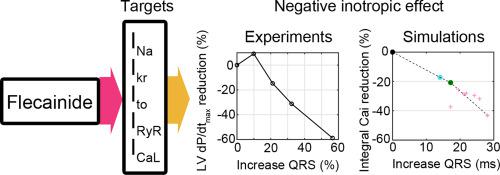Journal of Molecular and Cellular Cardiology ( IF 4.9 ) Pub Date : 2021-05-15 , DOI: 10.1016/j.yjmcc.2021.05.007 Pei-Chi Yang 1 , Wayne R Giles 2 , Luiz Belardinelli 3 , Colleen E Clancy 1

|
It is imperative to develop better approaches to predict how antiarrhythmic drugs with multiple interactions and targets may alter the overall electrical and/or mechanical function of the heart. Safety Pharmacology studies have provided new insights into the multi-target effects of many different classes of drugs and have been aided by the addition of robust new in vitro and in silico technology. The primary focus of Safety Pharmacology studies has been to determine the risk profile of drugs and drug candidates by assessing their effects on repolarization of the cardiac action potential. However, for decades experimental and clinical studies have described substantial and potentially detrimental effects of Na+ channel blockers in addition to their well-known conduction slowing effects. One such side effect, associated with administration of some Na+ channel blocking drugs is negative inotropy. This reduces the pumping function of the heart, thereby resulting in hypotension. Flecainide is a well-known example of a Na+ channel blocking drug, that exhibits strong rate-dependent block of INa and may cause negative cardiac inotropy. While the phenomenon of Na+ channel suppression and resulting negative inotropy is well described, the mechanism(s) underlying this effect are not. Here, we set out to use a modeling and simulation approach to reveal plausible mechanisms that could explain the negative inotropic effect of flecainide. We utilized the Grandi-Bers model [1] of the cardiac ventricular myocyte because of its robust descriptions of ion homeostasis in order to characterize and resolve the relative effects of QRS widening, flecainide off-target effects and changes in intracellular Ca2+ and Na+ homeostasis. The results of our investigations and predictions reconcile multiple data sets and illustrate how multiple mechanisms may play a contributing role in the flecainide induced negative cardiac inotropic effect.
中文翻译:

氟卡尼诱导负性肌力的机制:计算机研究
必须开发更好的方法来预测具有多种相互作用和靶点的抗心律失常药物如何改变心脏的整体电和/或机械功能。安全药理学研究为许多不同类别药物的多靶点效应提供了新的见解,并得到了强大的新体外和计算机技术的帮助。安全药理学研究的主要重点是通过评估药物和候选药物对心脏动作电位复极化的影响来确定药物和候选药物的风险状况。然而,几十年来的实验和临床研究已经描述了 Na +通道阻滞剂除了众所周知的传导减慢作用外。与施用一些Na +通道阻断药物相关的一种这样的副作用是负性肌力。这会降低心脏的泵血功能,从而导致低血压。Flecainide 是一个众所周知的 Na +通道阻断药物的例子,它表现出强烈的 I Na速率依赖性阻断,并可能导致负性心肌收缩力。而 Na +现象通道抑制和由此产生的负性肌力得到了很好的描述,但这种效应背后的机制却没有。在这里,我们着手使用建模和模拟方法来揭示可以解释氟卡尼负性肌力作用的合理机制。我们利用心脏心室肌细胞的 Grandi-Bers 模型 [1],因为它对离子稳态的有力描述,以表征和解决 QRS 增宽、氟卡尼脱靶效应和细胞内 Ca 2+和 Na变化的相对影响+体内平衡。我们的调查和预测结果协调了多个数据集,并说明了多种机制如何在氟卡尼诱导的负性心脏肌力作用中发挥作用。











































 京公网安备 11010802027423号
京公网安备 11010802027423号